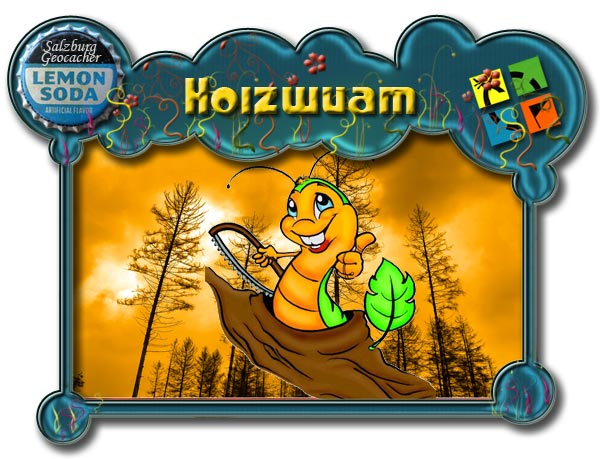
Hoizwuam - Der
Holzwurm
Der Gemeine
oder Gewöhnliche Nagekäfer (Anobium punctatum),
umgangssprachlich wegen der Aktivität der Larven auch Holzwurm
genannt, ist eine Art der Nagekäfer (Anobiidae).
Die
ausgewachsenen Käfer werden etwa 2,5 bis 5 Millimeter lang. In der
freien Natur findet man sie sehr selten, dann vor allem an
trockenem Laub- und Nadelholz, häufig unter Efeu.
Die Larven
des Nagekäfers befallen verbautes, also kein frisches Holz
(Trockenholzschädling). Aus den in Holzspalten oder Rissen
abgelegten Eiern schlüpfen die Larven, diese fressen sich durch das
Frühholz. Das Spätholz wird verschont und bleibt lamellenartig
stehen.
Nach mehreren
Wachstumszyklen verpuppt sich die ausgewachsene Larve. Nach seiner
Wandlung (Metamorphose) schlüpft ein geschlechtsreifer Käfer aus
der Puppe, der einen Kopulationspartner sucht. Die Ausfluglöcher
sind rund und haben einen Durchmesser von ein bis zwei Millimetern.
Nach erfolgter Befruchtung legt das Nagekäferweibchen seine Eier in
Ritzen, Spalten und Gänge des Holzes. Hier setzt sich dann der
Zyklus weiter fort. Die Entwicklungszeit der Larve dauert unter
günstigen Bedingungen ein Jahr, bei ungünstigen Bedingungen bis zu
acht Jahre; der schlüpfende Käfer legt seine Eier gern in das Holz,
in dem er selbst aufgewachsen ist.
Der Nagekäfer
ist grundsätzlich flugfähig und kann sich fliegend neue
Eiablageplätze suchen. Der Fraß konzentriert sich auf das
Splintholz, Kernholz wird nur selten angegriffen. Sind die Larven
aktiv, erkennt man das an herausquellendem Holzmehl. Legt man
schwarzes Papier oder Ähnliches unter die betroffenen Stelle, sieht
man bei Befallsaktivität nach wenigen Tagen Holzmehl auf dem Papier
(Fraßpausen berücksichtigen).
Die Larve des
Nagekäfers benötigt eine Mindestholzfeuchtigkeit von mehr als 10 %
und bevorzugt kühlere Orte — deshalb tritt er in zentralbeheizten
Räumen nur selten auf. Kritische Bereiche sind feuchte Räume oder
dort, wo Bodenkühle/-feuchte auftreten kann. Der Befall ist nicht
an ein Maximalalter des Holzes gebunden. Der Gemeine Nagekäfer kann
also durchaus auch jahrhundertealtes Holz befallen.
Quelle:
Wikipedia
Cache
Inhalt:
Logbuch - Stift mitbringen!
 Bitte den Cache wieder sehr vorsichtig, so verstecken, wie du ihn
vorgefunden hast!!
Bitte den Cache wieder sehr vorsichtig, so verstecken, wie du ihn
vorgefunden hast!!

The
woodworm
A woodworm is
not a specific species. It is the larval stage of certain
wood-boring beetles.
Woodboring beetles are commonly detected a few years after new
construction. The lumber supply may have contained wood infected
with beetle eggs or larvae, and since beetle life cycles can be one
or more years, several years may pass before the presence of
beetles becomes noticeable. If you have an infestation of
woodboring beetles, it is best to consult a professional
entomologist before contacting an exterminator. In many cases, the
beetles will be of a type that only attacks living wood, and thus
incapable of "infesting" any other pieces of wood, or doing any
further damage.[citation needed] In other words, only some types of
beetles should be of concern to a homeowner (see list below), and
exterminators may be unable or unwilling to make this distinction.
Consulting an entomologist can therefore potentially save a great
deal of worry and expense.
Genuine
infestations are far more likely in areas with high humidity, such
as poorly-ventilated crawl spaces. Housing with central
heating/air-conditioning tends to cut the humidity of wood in the
living areas to less than half of natural humidity, thus strongly
reducing the likelihood of an infestation. Infested furniture
should be removed from the house before the infestation
spreads.
Quelle:
Wikipedia
Cache
Content:
Logbook - NO pencil
 Please be very stealthy and rehide the
cache very carefully !!
Please be very stealthy and rehide the
cache very carefully !!

Happy
caching!